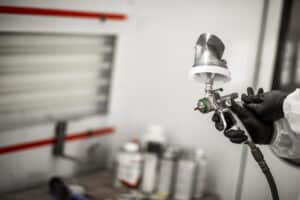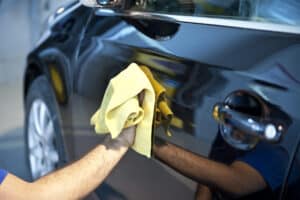Tips for Painting Car Bodywork in Winter
Painting car bodywork is a complex skill to master. From the myriad of techniques required to the best conditions for storing and curing automotive paints, repair professionals have a lot to consider. And when temperatures outside drop, repair specialists must be aware of how and when to change their procedures.
Cold weather can cause a huge variety of problems, from thickening paint to lengthy curing times. Here, we’ll explore the most common issues encountered by professionals during the painting process when temperatures plummet, alongside our expert advice for avoiding a poor-quality paint finish at the hands of bad weather conditions.
How Does Cold Weather Affect Car Paint?
Cold weather can affect each step involved in painting a vehicle. From storing the paint to applying and curing it, colder temperatures throw a variety of problems at auto repair specialists.
The main effects of cold weather on automotive painting are as follows:
- Paint adhesion: when the surface temperature of the vehicle is too low, the paint will struggle to adhere properly. This can lead to a rough and puckered surface since it might stick in some areas but not others.
- Paint thickening: Some paints thicken or harden when exposed to colder temperatures. This can make it more difficult to apply and contributes to the longer curing times.
- Solvent evaporating: Cold temperatures might cause solvents in the paint to evaporate and leave a bumpy, textured finish on the vehicle’s surface.
- Increased risk of condensation: Humidity is typically higher in winter, which can lead to condensation forming on the vehicle’s surface during the drying or curing process. This adds moisture to the vehicle and can leave you with an uneven finish.
The root of the issue with painting during winter is that the temperatures are low, and the humidity is high. Ultimately, cold weather can leave the vehicle’s surface with an undesirable finish after painting, which can leave you with a dissatisfied customer at the end of the repair job.
Can You Paint a Car in Winter?
The short answer is yes – it’s possible to paint a vehicle in winter. However, it’s important to note that to achieve a flawless paint finish, the process can be a little more complex than during other seasons. Just as warm weather can cause paint to dry and cure too quickly, cold weather has the complete opposite effect.

Professionals in the industry must take additional precautions during the process to ensure that the paint booth and the vehicle’s surface temperature don’t drop too low, and that paint is being stored at the correct temperatures. Humidity is also a major factor to consider when painting during winter since this can impact the finished result.
Tips for Painting Car Bodywork in Cold Temperatures
Struggling to achieve your typical high-quality paint finish in cold temperatures? Unsure how to speed up the drying and curing process? Below, we’ll guide you through our top tips for painting car bodywork during winter and address some of the issues you might face.
Warm the Vehicle in the Spray Booth
Although it can be easiest for many repair shops to store vehicles outside before working on them, this might not be the best practice during winter. When a vehicle is left outside in cold temperatures, its surface temperature tends to drop below the ideal level for automotive painting.
Bringing a cold vehicle into a warm spray booth can lead to problems with the paint failing to adhere because of thermal shock. This is typically caused by a sudden difference in temperature between the car body and the ambient temperature of the booth. The amount of humidity in the room can also play a big role in auto paint application during winter. Thermal shock can cause surface condensation to appear, which adds excessive moisture and makes repainting much more difficult.
To prevent this issue, the vehicle’s surface must be brought as close as possible to the ambient temperature of the spray booth. Use the heat from the paint booth to warm the vehicle or bring in heaters to speed up the process. The more control you have over the temperature, the better.
Ensure the Body is Properly Cleaned

The cold temperatures aren’t the only factor that can affect car painting in winter. Snow, rain, wind and other adverse weather conditions often leave vehicles covered in dirt, grit and other debris which must be thoroughly removed before beginning the painting process. A strong de-greaser and cleaning with specialist car surface shampoo should do the trick, but it’s important to pay close attention and check that no dirt is left on the surface before priming.
Store Paints Correctly to Ensure They’re at a Good Temperature
Most automotive paints will state that they should be kept around a specific temperature for best results. Colder weather can cause some paints to thicken or harden, which can make them more difficult to work with. Water-based paint products in particular are also at risk of freezing in extremely cold temperatures.
We recommend storing your automotive paints in a cupboard away from dampness and moisture. This should keep the paint warm enough during the winter months, while also being careful not to overheat the product.
Use Specialist Products
Several specialist products that can aid with the painting process when paint or surfaces are cold are available to try. One of the most worthwhile products to invest in is a slower-evaporating thinner. This can effectively thin your paint when it becomes too thick and aid with workability and paint levelling.
It’s also worth purchasing an infrared thermometer to easily find out the temperature of a room or surface. This technology will be incredibly handy in winter and summer when temperatures tend to be at their extremes.
Be Aware of Paint Viscosity & Use Correct Amount of Solvent
The cold weather can increase paint viscosity, which means that once mixed, your paint might require increased dilution. However, it’s important not to over-dilute the paint since this can thin it too much and lead to insufficient paint coverage.
To avoid a patchy application, pay close attention to the paint’s temperature and viscosity during the mixing process so that you can make the correct judgement before adjusting the viscosity. We recommend testing it before applying directly to the bodywork and allowing it to dry fully so that you can assess the paint coverage.
Prevent Condensation

Moisture from condensation must be avoided at all costs during the entire painting process, from application to curing. Not only can moisture cause automotive paint to apply unevenly, but it can also cause variations in curing time and the overall finish. Fans and dehumidifiers are a great investment if you find that your spray booth tends to be a humid environment because they can easily remove excess moisture from the air, leaving you with the perfect conditions to apply, dry and cure the paint.
Painting Car Bodywork in Cold Temperatures FAQs
Still have questions about painting car bodywork in colder temperatures? We’ve covered a few of the most commonly asked questions on the topic below.
What is the Ideal Temperature for Painting Car Bodywork?
For the best results when the weather is on the chillier side, ensure the temperature in your repair shop and the vehicle’s surface temperature consistently remain at roughly 21°C (70°F), while humidity levels should stay at around 50%. Most paints will cure in roughly 4 hours at this temperature, although this can depend on the surface area covered and the chemical composition of the automotive paint used.
Will Automotive Paint Cure in Cold Weather?
Yes, automotive paint will cure in cold temperatures. However, the curing process will be significantly slower and can even stop altogether if temperatures drop below 12°C (around 55°F). For the best finish, it’s advised to store automotive paint well above this temperature and check that both your paint and the spray booth are around 21°C (70°F) before beginning the painting process. The surface temperature of the vehicle should also be brought up to a similar level to avoid thermal shock.
Automotive painting can be adversely affected by the cold weather, but you can still achieve an excellent paint finish by understanding what changes need to be made. Our top tips can help guarantee that the quality of your paint jobs stays the same in every season, regardless of the temperatures you’re working in.
For more automotive painting tips and advice, check out the JTAPE blog.


